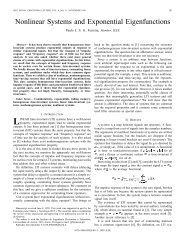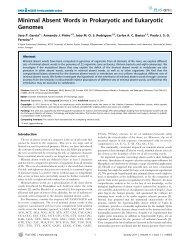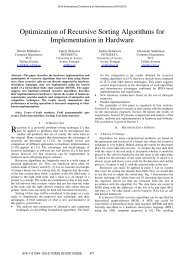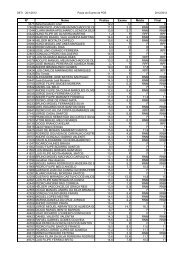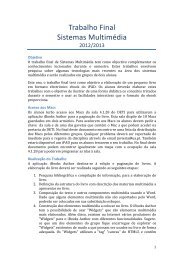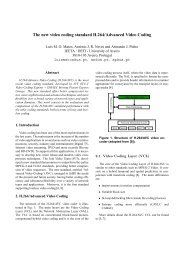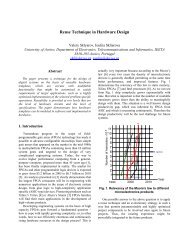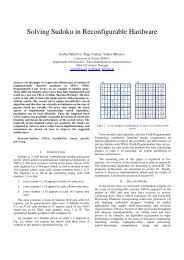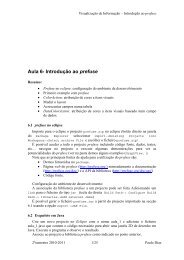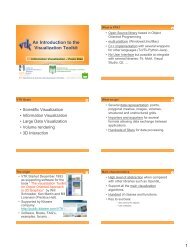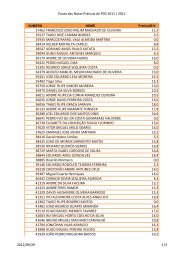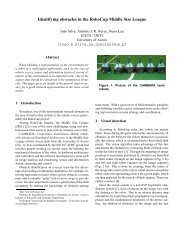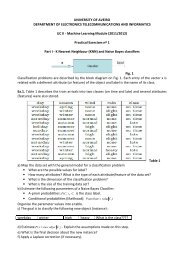DATA SHEET - IEETA
DATA SHEET - IEETA
DATA SHEET - IEETA
Create successful ePaper yourself
Turn your PDF publications into a flip-book with our unique Google optimized e-Paper software.
Philips Semiconductors Product specification<br />
8-bit microcontroller with on-chip CAN P8xC592<br />
22 CAN APPLICATION INFORMATION<br />
22.1 Latency time requirements<br />
Real-time applications require the ability to process and<br />
transfer information in a limited and predetermined period<br />
of time. If knowing this total time and the time required to<br />
process the information, the (maximum allowed) transfer<br />
delay time is given.<br />
22.1.1 MAXIMUM ALLOWED BIT-TIME CALCULATION<br />
1996 Jun 27 91<br />
It is measured from the initiation of the transfer up to the<br />
signalling of reception.<br />
For instance, this is the period of time between<br />
programming the CAN Command Register bit 0<br />
(Transmission Request) to HIGH and the time getting an<br />
interrupt at a receiving CAN-device (due to the reception<br />
of the respective message).<br />
The maximum allowed bit-time (tBIT) due to latency time requirements can be calculated as:<br />
tBIT ≤ --------------------------------------------------------------------------------------------<br />
( nBIT, MAX LATENCY + nBIT, MESSAGE)<br />
Where:<br />
• tMAX TRANSFER TIME:<br />
the maximum allowed transfer delay time (application-specific).<br />
• nBIT, MAX LATENCY:<br />
the maximum latency time (in terms of number of bits), which depends on the<br />
actual state of the CAN network (e.g. another message already on the network);<br />
• nBIT, MESSAGE:<br />
the number of bits of a message; it varies with the number of transferred data bytes<br />
n<strong>DATA</strong> BYTES (0..8) and Stuffbits like:<br />
Example:<br />
For the calculation of nBIT, MAX LATENCY the following is assumed (the term ‘our message’ refers to that one the latency<br />
time is calculated for):<br />
• since at maximum one-bit-time ago another CAN-controller is transmitting.<br />
• a single error occurs during the transmission of that message preceding ours, leading to the additional transfer of one<br />
Error Frame<br />
• ‘our message’ has the highest priority,<br />
giving:<br />
t MAX TRANSFER TIME<br />
44 + 8.n<strong>DATA</strong> BYTES ≤nBIT, MESSAGE ≤52<br />
+ 10.n<strong>DATA</strong>BYTES nBIT, MAX LATENCY ≥44<br />
+ 8.n<strong>DATA</strong> BYTES, WORST CASE + 18<br />
nBIT, MAX LATENCY ≤52<br />
+ 10.n<strong>DATA</strong> BYTES, WORST CASE + 18<br />
Where:<br />
• The additional 18 bits are due to the Error Frame and the Intermission Field preceding ‘our message’.<br />
• n<strong>DATA</strong> BYTES, WORST CASE denotes the number of data bytes contained by the longest message being used in a given<br />
CAN network.<br />
(1)<br />
(2)<br />
(3)<br />
(4)



